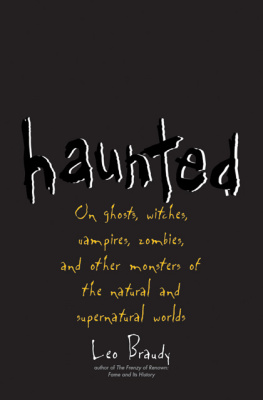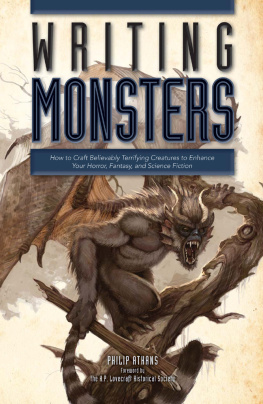Haunted
ALSO BY LEO BRAUDY

Trying to Be Cool: Growing Up in the 1950s (2013)
The Hollywood Sign: Fantasy and Reality of an American Icon (2011)
On the Waterfront (2005)
From Chivalry to Terrorism: War and the Changing Nature of Masculinity (2003)
Native Informant: Essays on Film, Fiction, and Popular Culture (1992, 2008)
The Frenzy of Renown: Fame and Its History (1986, 1997)
The World in a Frame: What We See in Films (1976, 1984, 2002)
Jean Renoir: The World of His Films (1972, 1989)
The Plot of Time: Narrative Form in Hume, Fielding, and Gibbon (1970, 2003)

Published with assistance from the foundation established in memory of Philip Hamilton McMillan of the Class of 1894, Yale College.
Copyright 2016 by Leo Braudy.
All rights reserved.
This book may not be reproduced, in whole or in part, including illustrations, in any form (beyond that copying permitted by Sections 107 and 108 of the U.S. Copyright Law and except by reviewers for the public press), without written permission from the publishers.
Yale University Press books may be purchased in quantity for educational, business, or promotional use. For information, please e-mail (U.K. office).
Set in Adobe Garamond type by IDS Infotech, Ltd.
Printed in the United States of America.
ISBN 978-0-300-20380-6
Library of Congress Control Number: 2016937700
A catalogue record for this book is available from the British Library.
This paper meets the requirements of ANSI/NISO Z39.48-1992 (Permanence of Paper).
10 9 8 7 6 5 4 3 2 1
For Dorothy, eternally
Contents

Preface
Who doesnt know the stories? The corpses rising from the grave, the blood-sucking vampires that fly by night, the man-made creature who turns against his creator and murderously stalks the land, the gigantic beast bent on annihilating anything human, the man who has found the magic potion that turns him into a monster. Theyre as familiar as the story of Moses leading the Israelites out of Egypt, or the Crucifixion, or the Hegira, or the Buddha teaching under the Bodhi tree. But instead of the foundational stories of a religion, they are stories of horror and terror that have generated more and more monsters as they are told and retold over the centuries. They arent just in books or moviesthey are under the bed or they leap out of the closet, they scrape on the window in the dead of night, and they reside patiently in the attic, in the basement, in every patch of darkness and shadow, waiting to pounce.
Why have the monsters born or reborn in past centuries continued to have such a hold on our imaginations? How have they become handy metaphoric ways of describing the dark side of ourselves as well as epithets to hurl at our enemies, as heartless automatons or predatory bloodsuckers or mindless animals, all bent on our destruction? The monsters are before us in both senses: they seem to come from a dark past, but they stand in front of us every day.
Two linked impulses moved me to write Haunted, both of which have infused my work since the start. The first is to connect elements in a culture without recourse to a hierarchy of high and low, the soft aesthetic values versus the hard political and economic ones. The second is to explore how emotions themselves can have a history. Haunted is thus very much akin to my earlier books The Frenzy of Renown (on the history of fame and the desire to be known) and From Chivalry to Terrorism (on the changing relationship between war and ideas of masculinity). It takes a cultural phenomenon that seems to be of the present (here the hordes of zombies, vampires, monsters, and other figures that crowd contemporary culture) and seeks to show not only that it has a history but also how it has evolved. Why it is that these terrifying figures have been so endlessly present since the days of the eighteenth-century political revolutions and the optimism of the Industrial Revolution, when it seemed that politics based on reason and knowledge based on empirical science would have been expected to vanquish such phantasms from human consciousness forever. Instead those fears grew and expanded to furnish a continuing contradiction to and commentary upon the ambitions, assertions, and perhaps pretensions of the modern world itself.
Haunted shares with Frenzy and Chivalry the conviction that a knowledge of history is crucial for understanding many of those connections that otherwise seem a matter of timeless emotions: the connection to religion and our deepest beliefseven among the unreligiousabout chance, nature, the past, the inner life, and life after death. Through the distorted prism of horror, Haunted considers not just the invariable elements of fear, but also how fear is shaped, as well as how those images warp our politics and our understanding of the world. In part my goal is to foster a historical and cultural understanding of the idea of the monstrous as a way of freeing ourselves from the unconscious control of images otherwise rooted in our childhood apprehension of the world of darkness and invisible powers. I dont want to minimize the emotional attraction of these images, or banish them from rational discourse; I want to understand their attraction, as well as the incessant combat between reason and emotion in ourselves and in our public life.
Fear is the pervasive topic of our times. Neuroscientists discuss it in terms of brain function; sociologists and anthropologists investigate it in terms of social attitudes; horror fans luxuriate in its monster shapes and its film and literary history; politicians manipulate it. This book in great part deals with the evolution of a repertoire of monsters and monstrous images that come ready to hand as ways of understanding not only what is abnormal, what is to be hated and despised, but also what is compelling in its supernatural allure. It is commonplace to say that monsters and phantasms have always haunted human dreams. But I am interested here in those historical moments when the scattered fears of the past coalesce into more pervasive terrors, when the old stories meet new circumstances that expand and intensify their meaning.
Many times, in the course of my discussion, I have touched on issues that take up several library shelves, whether in religion, law, literature, science, and elsewhere. Many of these areas of study are controversial, and their authors are often a confusing but heady mixture of the academic, the fan, and the believer. As much as I could within the compass of my argument, I have tried to absorb the insights of scholarship as well as enthusiasm without delving excessively into often fascinating disputes that in themselves are well worth exploring. In its discussion of the relation of horror to religion, for example, Haunted is not so much about the intricate historical investigations that have taken place into the nature of belief in demons versus the rarefied realm of demonological theory. Instead, it considers how those long-ago arguments have created a reservoir of imagery that continues to shape popular culture and is drawn upon freely when paranoia and crisis again distort our sense of reality.
Next page










